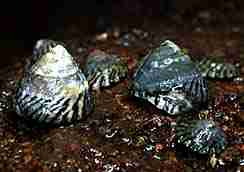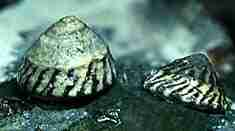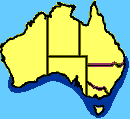|
|

Striped-mouth Conniwink Bembicium nanum
Form:
 The
Striped-mouth Conniwink's shell is wider than high and is cone-shaped,
with a flattened base. The dominant sculpture
occurs on the base whorl, where there are about eight low concentric ridges.
Other whorls may be smooth,
or with small nodules.
The
Striped-mouth Conniwink's shell is wider than high and is cone-shaped,
with a flattened base. The dominant sculpture
occurs on the base whorl, where there are about eight low concentric ridges.
Other whorls may be smooth,
or with small nodules.
Colour:
 The
Striped-mouth Conniwink's shell colour is grey or white with oblique brown
and white bands, dominant on last whorl.
The
Striped-mouth Conniwink's shell colour is grey or white with oblique brown
and white bands, dominant on last whorl.
The interior is shiny, with dark brown stripes on the outer edge.
The operculum is yellow-brown.
Phylum: |
Mollusca |
Author: |
Lamarck, 1822 |
Family: |
Littorinidae |
Size: |
10 mm diameter |
Distribution:
 The
Striped-mouth Conniwink ranges from southern Queensland, along the New
South Wales coast, and across Victoria, Tasmania, and South Australia
to the Perth region of south-western Western Australia.
The
Striped-mouth Conniwink ranges from southern Queensland, along the New
South Wales coast, and across Victoria, Tasmania, and South Australia
to the Perth region of south-western Western Australia.
Habitat:
It occurs from mid to high-tide levels on exposed rocks and shore platforms.
Biology:
The Stripe-mouth Conniwink lays bean-shaped jelly egg masses about 2.5 mm long and 1.5 mm wide. The egg masses are attached firmly in groups to the rock surface. Each mass holds 100-200 cream to white-coloured eggs. After 18-28 days the dark-brown larvae reach the veliger stage, where they break free to become part of the plankton. The veliger then drifts around in the ocean for several weeks until it reaches a suitable settling site.
References:
Bennett, I. (1987) W. J. Dakin's classic study: Australian Seashores. p. 191, Angus & Robertson, Sydney.
Davey, K. (1998) A Photographic Guide to Seashore Life of Australia. p.98, New Holland, Sydney.
Edgar, G. J. (1997) Australian Marine Life: the plants and animals of temperate waters. p.244, Reed Books, Kew.
Quinn, G. P., Wescott, G. C. & Synnot, R. N. (1992) Life on the Rocky Shores of South-eastern Australia: an illustrated field guide. p.46, Victorian National Parks Association, Melbourne.
Marine Research Group of Victoria (1984) Coastal Invertebrates of Victoria: an atlas of selected species. p.46, Museum of Victoria, Melbourne.
Macpherson, J. H. & Gabriel, C. J. (1962) Marine Molluscs of Victoria. p.89, Melbourne University Press & The National Museum of Victoria.
Shepherd, S.A. & Thomas, I. M. (1982) Marine Invertebrates of Victoria, Pt. 2. p. 567, South Australian Government Printer, Adelaide.
Underwood, A. J. & Chapman, M. G. (1993) Seashores: a beachcomber's guide. p.30, New South Wales University Press, Sydney.
Molluscs
Periwinkles,
Conniwinks &
Clusterwinks
Blue
Australwink
Tubercled Noddiwink
Striped-mouth Conniwink
Home
Page
Taxonomy
Biogeography
Rocky Shores
Tidal Levels
Intertidal Zonation
Environmental Factors
Biological
Factors
Feeding Relationships
Activities
Glossary
References
 Life
on Australian Seashores
Life
on Australian Seashores
by Keith Davey (C) 2000
Learning Consultant
- Media
The University of Newcastle
email at australian_seashores@hotmail.com
Scientific Consultant: Phil
Colman
site created 01.01.98 : updated 01.04.2000